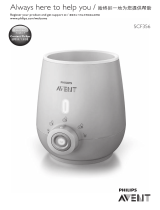
16 ENGLISH
Disposal
Your product is designed and manufactured with high quality materials and
components, which can be recycled and reused. For recycling information, please
contact your local waste management facilities or visit www.recycle.philips.com.
Troubleshooting
This chapter summarizes the most common problems you could encounter with
the appliance. If you are unable to resolve the problem with the information below,
contact the Consumer Care Center in your country.
Problem After switching on the bottle warmer, the entire progress indicator
blinks fast and switches o.
Cause
•
The temperature of water in the bottle warmer is too hot or too
cold.
•
The boil-dry protection is activated.
Solution
•
Switch o and unplug. Let it cool down for a few minutes. Make
sure you ll it with fresh room temperature water.
•
The bottle warmer automatically switches o if it is on and there
is no water or not enough water in it. Switch o and unplug. Let
it cool down rst. Make sure you ll it with enough fresh room
temperature water. The bottle warmer is ready to use again.
Problem The milk is too hot.
Cause
•
You may have selected an incorrect setting or are using a milk bag.
Solution
•
Select the milk volume setting based on the milk volume, not the
bottle size.
•
If you are using a milk bag, select the keep warm / defrost setting.
Problem The milk is still cold.
Cause
•
You may have selected an incorrect setting, are using a silicone
bottle, or have lled the bottle warmer with warm water.
Solution
•
Select the milk volume setting based on the milk volume, not the
bottle size.
•
If you are using a silicone bottle, select the milk volume setting
based on the milk volume. When the entire progress indicator is
on, wait for 3-4 minutes for the milk to warm.
•
Fill the bottle warmer with fresh room temperature water. Do not
use warm water.
























